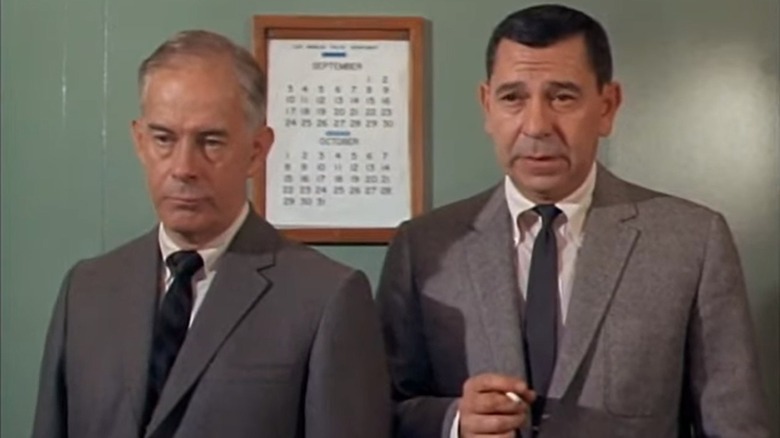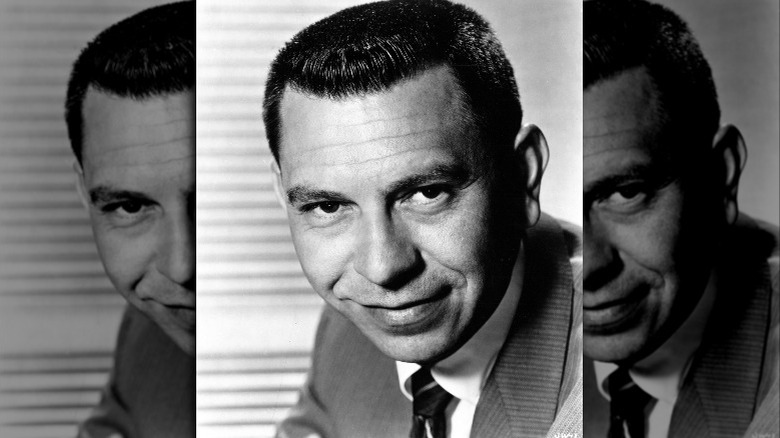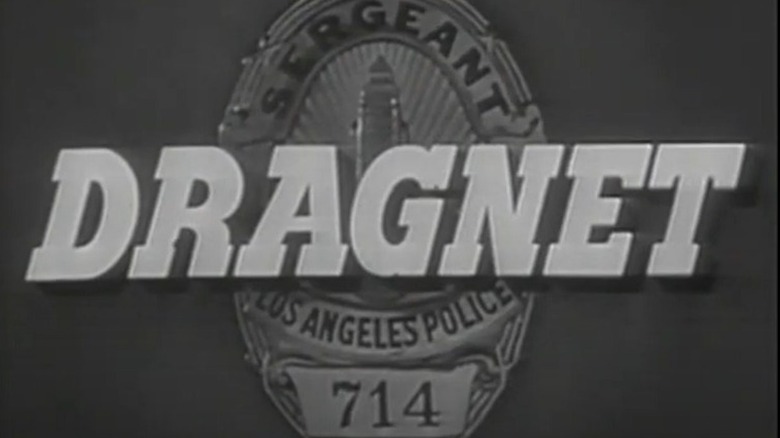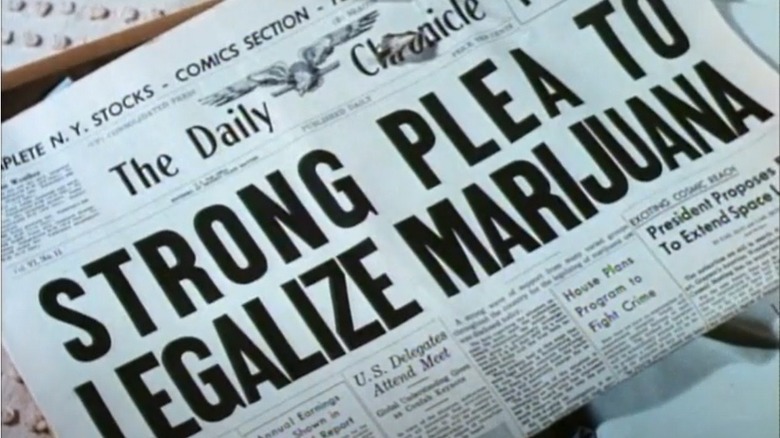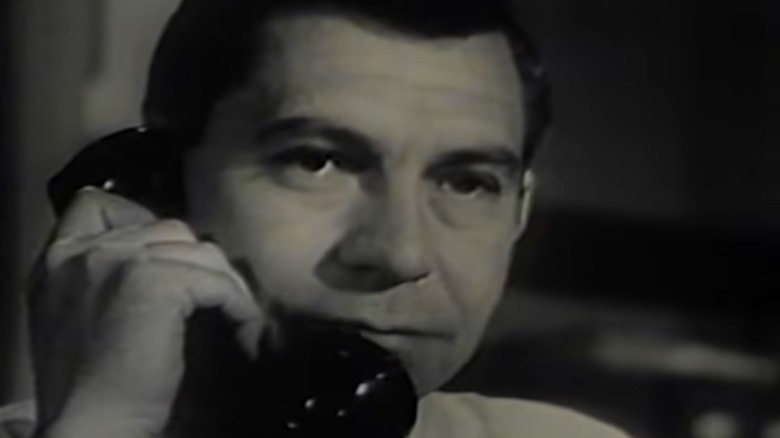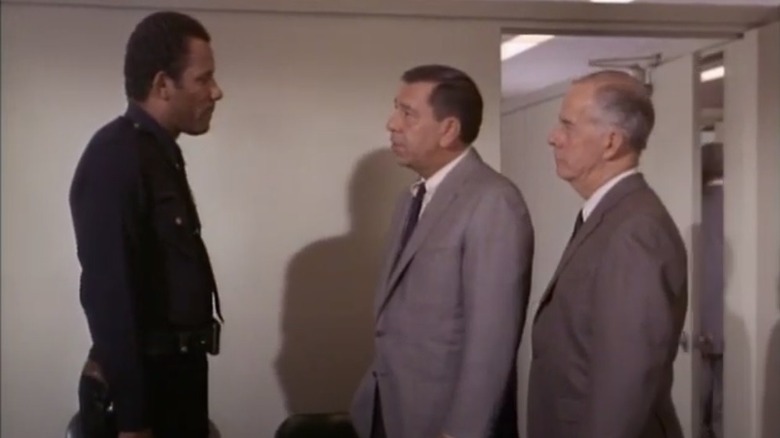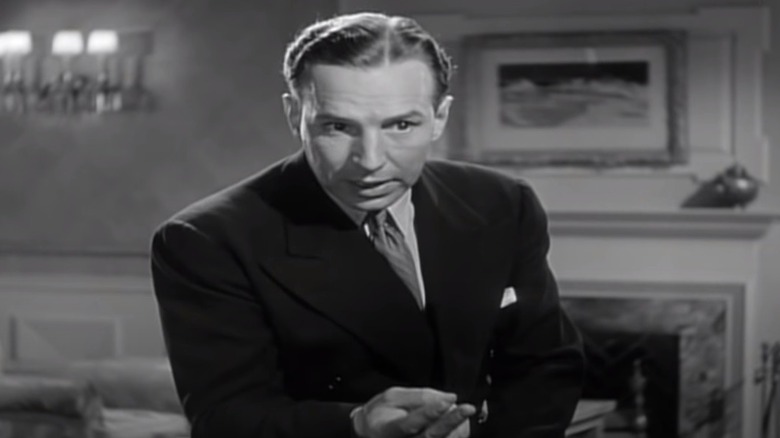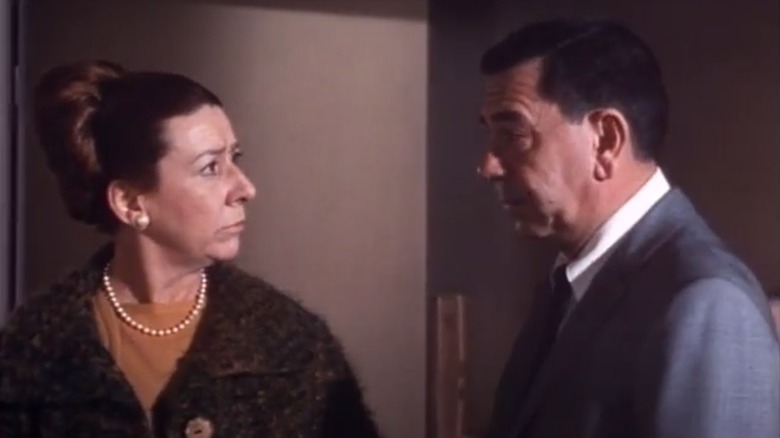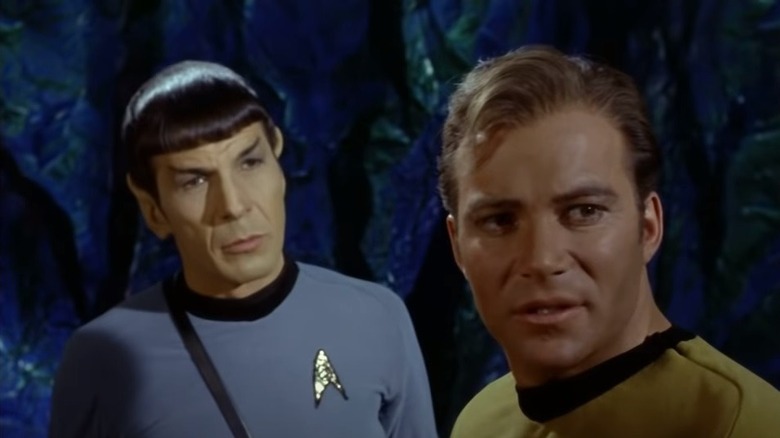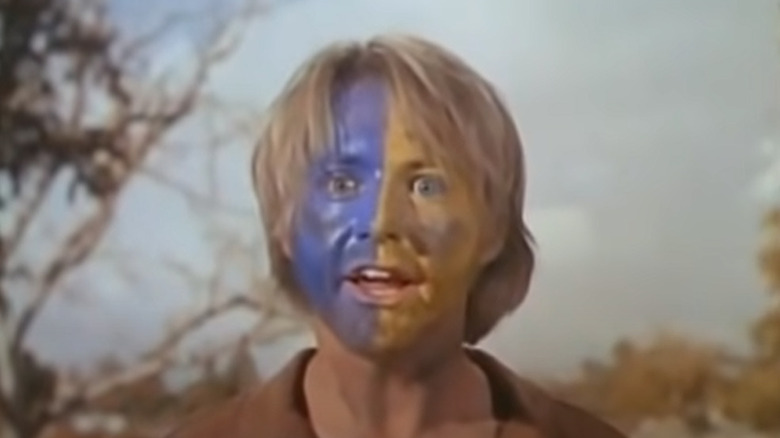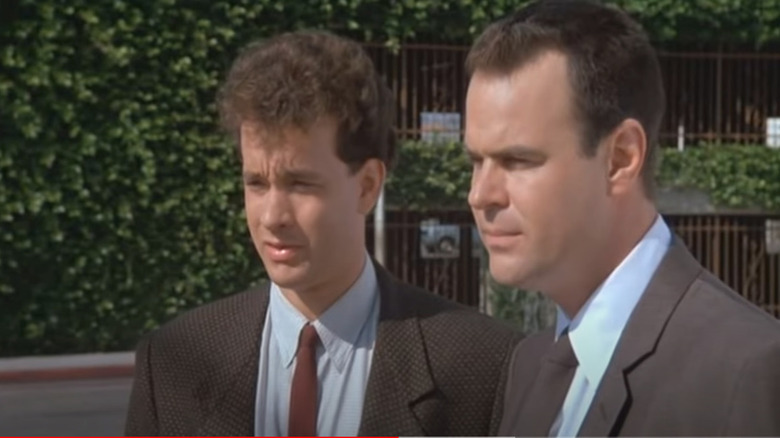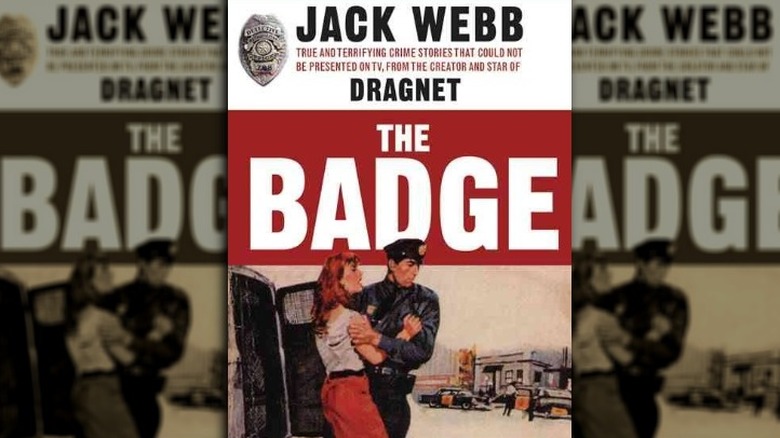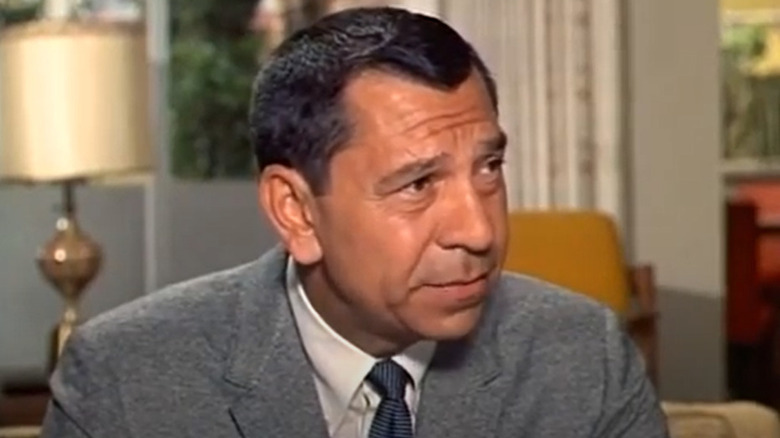The Untold Truth Of Dragnet
Decades before "CSI," "Law and Order," and "Broadchurch," brought criminal investigation into the homes of TV viewers around the world, "Dragnet" set the template for the modern police procedural. Created by and starring Jack Webb as Los Angeles police detective Joe Friday, "Dragnet" presented a realistic depiction of police work devoid of the car chases and gunfights that often characterized cop shows. From homicide to shoplifting, no crime was too big or too small for the dogged Friday to crack and both radio and TV audiences couldn't get enough of the strait-laced lawman.
"Dragnet" began as a radio drama in 1949, making the leap to the small screen in 1951. Hailed by police departments across the United States for its unwavering attention to detail and realistic portrayal of investigative procedures and law enforcement, the first television incarnation of the show ran for 8 seasons from 1951 to 1959. However, not even low ratings could keep Joe Friday down. In 1967, "Dragnet" returned to TV. Friday, again played by Webb, was back to face the social upheaval of the era with his patented deadpan approach. For older viewers, the super-conservative detectives represented a bastion of traditional values in a world that was changing too fast. To the disaffected and the counterculture, "Dragnet" was a preachy fairytale of police work that didn't reflect the reality of the streets.
The story you're about to read is true. No names have been changed to protect the innocent. This is the untold truth of "Dragnet."
Jack Webb's hard road to Dragnet
As detailed by biographer Michael J. Hayde, "Dragnet" creator Jack Webb was born on April 2, 1920, in Santa Monica, California. Shortly after his birth, Webb's father left the family never to return. Webb would spend his formative years in LA's poverty-ridden Bunker Hill neighborhood.
Raised by his alcoholic mother and his grandmother, Webb was a sickly child. A bout of pneumonia nearly killed him at age four. Severely asthmatic, he was forbidden to play with the neighborhood children and spent his days rummaging through garbage cans for discarded magazines. Webb's grandmother taught him to read by outlining the letters on a box of salt, and soon he was spending his days in the public library. On the rare occasions when he could scrounge a nickel for the movies, he spent hours in the theater.
While a student at Belmont High School, Webb began producing variety shows to raise money to help buy uniforms for the football team. It was during these fundraisers that he got a taste of his future radio career. An excellent student, he won a scholarship to the Chouinard Art Institute but, as his family's sole breadwinner, was unable to accept. With the outbreak of World War II, Webb joined the Army Air Corps with hopes of becoming a combat aviator. Unfortunately, he washed out of the program without earning his pilot wings. Soon after, his military career ended when he was given a dependency discharge to care for his ailing and destitute mother and grandmother.
Dragnet began as radio drama
Jack Webb's time in the Army was not a complete waste. According to author Michael J. Hayde, while working as an Army clerk and typist, Webb also began helping with USO shows. Acting as an emcee, Webb developed the powerful voice which would help land a job at San Francisco radio station KGO after his discharge. A workaholic, Webb wrote and produced a number of successful dramas and music programs including the hardboiled crime series "Pat Novak for Hire" in which Webb also starred.
The success of "Pat Novak for Hire" spurred Webb to move to Hollywood where he scored a small part as a police detective in the 1948 film-noir, "He Walked by Night." While working on "He Walked by Night," Webb met police Sgt. Marty Wynn who served as a technical adviser on the movie. According to "Icons of Mystery and Crime Detection," Wynn took issue with the over-the-top way cops were portrayed in the media and suggested that Webb "do something" based on real cases. With that, the seeds of "Dragnet" were sown.
Webb spent a year developing the idea. To ensure accuracy, he spent time at police headquarters, rode along with detectives on calls, and took classes at the police academy. CBS radio executives rejected "Dragnet" for its lack of action. However, NBC accepted the innovative police show. The radio incarnation of "Dragnet" would last from 1949 to 1957 for a total of 382 original shows and ran concurrently with the TV version for its last five years.
Dragnet never shied away from controversy
"Dragnet" never shied away from controversial subject matter. From drug addiction to sex crimes, the show dealt with serious and timely topics that other programs considered taboo. A 1950 radio episode titled "The Big Picture," adapted for TV in 1959, found Joe Friday taking on a pair of fake Hollywood talent scouts who lure young women into illegal sex work. In the 1968 episode, "The Starlet," Friday and partner Bill Gannon's search for teen a runaway leads them to the lair of a sleazy pornographer.
However, one of the show's most controversial stories, first aired on radio in 1949 and then filmed for TV in 1952, was ".22 Rifle for Christmas." In this holiday episode, Joe Friday receives a call about a missing 9-year-old boy named Stanley Johnstone. Soon, another small boy is reported missing. Friday's only clues are a spent .22 cartridge and some bloodstains. When the detective discovers Johnstone's Christmas gift of a .22 rifle is also missing, his worst suspicions are confirmed. A tearful Johnstone returns to reveal his playmate has fatally shot himself with the purloined present.
As detailed in "My Name's Friday," by Michael J. Hayde, the show received a mostly positive response from viewers. However, the National Rifle Association strongly objected to the episode in a letter to Webb. The "Dragnet" creator turned the letter over to LAPD which promised the pro-gun organization that they could expect at least 10 more episodes "illustrating the folly of giving rifles to children."
Jack Webb was a stickler for realism
Jack Webb was obsessive when it came to the depiction of police work in "Dragnet." From the beginning, Webb insisted that "Dragnet" would be a police show, not a crime show. To that end, the commission of the crime at the center of every script was never part of the main plot. The drama was generated by the investigation from the discovery of clues to collaring the suspect. Consequently, the show avoided the gunplay and violence that was inherent in most cop dramas. The lack of action left NBC radio executives reeling. As detailed in "My Name's Friday," after the first episode aired, the network demanded Webb pick up the pace and up the violence for the sake of drama. Webb politely acknowledged NBC's concerns and continued to do things his way with the help of the LAPD. Although names were famously changed to protect the innocent, the names of real Los Angeles police officers and officials regularly appeared in "Dragnet" episodes as well as the department's actual radio call sign, KMA-367.
In 1951, "Dragnet" became one of the first the first radio programs to graduate to TV. With the addition of the visual element, Webb was free to add another level of realism to his creation. In addition to such details as real LAPD badges, squad cars, and insignia, Webb had the offices and décor of LA's Police Administration Building recreated in painstaking detail complete with adjustable exterior lighting to simulate day and night and huge photographic backdrops of the LA skyline for the windows.
Cops loved Dragnet, but the truth was complicated
Its attention to detail and depiction of the LAPD as nearly infallible defenders of the public made "Dragnet" especially popular with police officers. According to the website of the Los Angeles Police Museum's Jack Webb Awards, "Dragnet" so elevated the image of the LAPD and their investigative procedures that police departments across the United States began using the program as a training tool. Some went as far as timing roll calls around airings of the show.
As detailed in "My Name's Friday," fan mail for the show poured in from law enforcement personnel. A patrolman from Rhode Island wrote, "If the law enforcement agencies had more programs of your type that gave the true information on police work instead of the 'glorified criminal, cops-and-robbers' type, their job would be much easier... " "... You are doing more for law enforcement than anyone else in the entertainment field," a former FBI agent stated in a letter to Webb.
Despite its vaunted accuracy and excruciating attention to detail, "Dragnet" was essentially a pro-police propaganda outlet that largely ignored the reality of the streets. Webb would never reveal that the LAPD was plagued by scandal, racism, and corruption. Relations between the police and Black and Latino Angelinos were, at best, strained, and, at worst, openly hostile. Under the auspices of Chief William Parker, whom Webb idolized, the department adopted an overly aggressive approach to policing that included the unwritten edict, "never admit the department has done anything wrong."
TV's Dragnet could have had a different Joe Friday
Jack Webb's deadpan, no-nonsense portrayal of Detective Joe Friday is as synonymous with "Dragnet" as the famous four note musical motif that began each episode. Although it's virtually impossible to imagine anyone else in the role, Webb had no interest in playing the character on TV. Content to stay behind the scenes as "Dragnet's" producer and director, Webb believed that he just didn't have the face of a TV star. As documented in Michael Hayde's "My Name's Friday," Webb made his case for recasting directly to the show's sponsor stating, "I've seen myself in the mirror. I know the size of my ears."
The actor that Webb picked to play Joe Friday was Lloyd Nolan. By the 1950s, Nolan had made a reputation as a reliable and competent actor whose performances regularly transcended the "B" grade, hardboiled detective thrillers in which he was often cast. Best known for portraying detective Michael Shayne in a series of films throughout the early 1940s, Nolan worked steadily in film and TV until his death in 1985 with notable roles in such movies as "Ice Station Zebra" and "Peyton Place."
However, NBC would have none of it. There was only one Joe Friday and the network meant to have Webb in the part, big ears and all. Webb, who continued to play the role on radio, at last relented.
Joe Friday never said 'Just the facts, ma'am'
Just as James T. Kirk never said, "Beam me up, Scotty," and Darth Vader never said, "Luke, I am your father," Detective Joe Friday never uttered the famous catchphrase, "Just the facts, ma'am." The actual line took two forms: "All we want are the facts, ma'am" and "All we know are the facts, ma'am."
Although fans of classic television no doubt clearly recall Jack Webb's stalwart detective imploring a meandering witness to get on with her statement with the famous phrase, they need not worry that they've slipped into an alternate timeline. Like "Beam me up, Scotty," "Just the facts, ma'am," as reported by the professional fact checkers at Snopes, stems from a combination of faulty memories, pop cultural appropriation, and simple rephrasing of a real line of dialogue.
According to Michael J. Hayde, author of "My Name's Friday: The Unauthorized but True Story of Dragnet and the Films of Jack Webb," the phrase entered the lexicon thanks to a pair of comedy sketches from comedian Stan Freberg. "St. George and the Dragonet" with the B-side "Little Blue Riding Hood" was released to radio 1953. "Dragnet"-inspired parodies of the legend of St. George and the dragon and the classic fairytale delivered in Joe Friday's famous monotone, the single was an immediate success. On the record, Freberg says, "I just want to get the facts, ma'am." The phrase was truncated in the popular imagination, and from that point on, became an indelible part of the show's legacy.
Dragnet's Star Trek connections
In 1948, "Star Trek" creator Gene Roddenberry left his job as an airline pilot with hopes of becoming a professional writer. Still in need of a steady income, he followed in his father's footsteps and joined the LAPD. Soon, Roddenberry put his skills to use writing articles for the department's in-house magazine, and as a speechwriter for police chief William Parker. As detailed in David Alexander's "Star Trek Creator: The Authorized Biography of Gene Roddenberry," "Dragnet's" partnership with the LAPD gave Roddenberry his start in TV writing. Although he didn't write complete teleplays for the show, Roddenberry did submit ideas and treatments.
Two other key "Star Trek" writers also found early success with "Dragnet." John Meredyth Lucas, who would go on to write four episodes and serve as a producer and director on the classic sci-fi series, contributed the 1957 episode "The Big Blank." Gene L. Coon, the writer-producer-director responsible for creating Klingons and other elements of the show's lore, wrote the 1959 "Dragnet" episode "The Big Appetite."
Surprisingly, Klingons have yet another link to Jack Webb's cop show. Gene L. Coon, stuck for a name for a new hostile alien race he was developing, overheard Roddenberry talking about a friend from the LAPD named Wilbur Clingan. Coon liked the ring of Clingan and altered the spelling. Lieutenant Clingan is mentioned by name in several episodes of "Dragnet 1967" and appears as portrayed by actor Dennis McCarthy in the episode "The Missing Realtor."
Dragnet got freaky with its first '60s episode
Declining ratings led to "Dragnet" leaving TV in 1959. Sold into syndication as "Badge 714," the show found new life in reruns. By the mid-1960s Jack Webb, who was slowly pulling himself out of a career slump after a series of disappointing TV and film projects, took note of the show's resurgence in popularity. Feeling the time was right to bring "Dragnet" back, he sold NBC on the idea for the second time.
As detailed in "Crime Television" by Douglas Snauffer, Webb was fully aware that times had changed since the show's heyday in the '50s. Written by Webb under the pseudonym John Randolph, "Dragnet '67's" debut installment, "The LSD Story," finds Friday and partner Bill Gannon, played by Harry Morgan," disturbed by the rise of a new, hallucinogenic drug which has LA's youth chewing the bark off of trees and burying their heads in the ground to gaze at the "purple pilot light of all creation."
Initially unable to act because LSD had not yet been classified as illegal, the duo finally go after a notorious dealer known as "Blue Boy" (named for his drug-induced penchant for face-painting) when LSD is outlawed. Sadly, they arrive too late. "Blue Boy," in an attempt to get "farther out," has died of an overdose. Considered a cult classic for its off-the-wall depiction of the counterculture, "The LSD Story" was declared the 85th Greatest Episode in television history in a "TV Guide"/Nick at Nite poll.
Dragnet and the movies
Released in 1954, the first cinematic "Dragnet" was shot in color and upped the violence quotient of its TV counterpart considerably. With a plot centered on the gangland slaying of an ex-convict, the "Dragnet" film was a showcase for Webb's exploration of investigative techniques.
As detailed in Mitzi Brunsdale's "Icons of Mystery and Crime Detection," Webb sold the second "Dragnet" series to NBC based on the merits of the telefilm "Dragnet '66." Shot on a limited budget, the movie departed from Webb's obsessive realism and showed a more compassionate side of Joe Friday. Although it led directly to "Dragnet's" TV revival, NBC shelved the film, finally airing it in 1969.
In 1987, "Dragnet" returned to the big screen as a comedy starring comic actor Dan Aykroyd as the original Joe Friday's nephew. Academy Award winner Tom Hanks co-stars as partner Pep Streebeck who's modern approach to crime fighting puts him at odds with the by-the-book Friday.
Dragnet on the page
As documented in "Icons of Mystery and Crime Detection," "Dragnet" was heavily merchandised to both adults and children. Junior Joe Fridays armed with official "Dragnet" toy revolvers could solve pretend crimes with their very own "Dragnet" Badge 714 Crime Lab Kits. Lucky girls and boys might even find a genuine Jack Webb "Dragnet" Whistle in their breakfast cereal.
"Dragnet" also produced its share of ancillary media. In 1952, "Dragnet" became a popular syndicated comic strip. Appearing daily in newspapers across the United States, the strip ran until 1955.
David Knight's "Case 561," the first of many "Dragnet" novels, was published in 1956. Author Richard Deming wrote several books for both children and adults based on the 1950s and '60s versions of the show. Also essential reading for "Dragnet" fans is Jack Webb's 1958 book "The Badge." An inside look at the LAPD, "The Badge" covers cases considered too extreme for TV including the infamous Black Dahlia murder.
The '80s Dragnet revival that never was
Although the second TV version of "Dragnet" ended in 1970, Jack Webb remained active throughout the decade as the creator of the police drama "Adam-12" and its spinoff "Emergency."
As the 1980s dawned, Webb noticed that the times were changing once again. As reported by MeTV, Webb wrote five scripts for a new version of "Dragnet" he hoped to get on the air in 1983. Webb was to return as Joe Friday, but with Harry Morgan committed to "MASH" and its sequel series "AfterMASH," he would need a new partner. Webb picked "Adam-12's" Kent McCord to fill the role.
Sadly, the new "Dragnet" would never happen. On December 23, 1982, Jack Webb died of a heart attack at age 62. On the day of Webb's death, LA police Chief Daryl Gates retired Joe Friday's Sergeant Badge 714. Webb was granted a funeral with full police honors by the LAPD.
